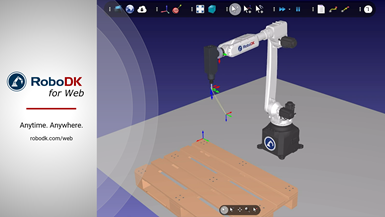Free Web Version of RoboDK Offers Accessibility, Ease of Use
RoboDK’s new web version provides a free, installation-free option for creating simple robotic programs and loading pre-made simulations.
Share






Image credit: RoboDK
has released a new, of its robot programming software, also called RoboDK. The company sees this web version appealing to integrators performing sales demonstrations, new users of robotic automation, and educational users.
“Getting started with new software can sometimes be daunting,” says Flore Cachera, head of marketing at RoboDK. “The web version of RoboDK is very basic so that every user can get familiar with the environment. Our goal is to make the software more accessible and provide a global vision of what RoboDK can offer in just a few clicks.”
Supporting this goal, RoboDK’s web version requires no installation. Users can access the web version and its basic functionalities on any major browser, creating proof-of-concept simulations and simple programs leveraging any of the over 600 robot arms from over 50 robot manufacturers in the RoboDK library. If the customer decides to purchase the full desktop version, they can transfer projects from the web version to the desktop software. The web version supports many different 3D model and machining file types, including STEP, IGES, G-Code, APT and others. Integrators with the full desktop version can also upload simulations to custom web addresses, where that simulation will be pre-loaded for anyone with the link.
Related Content
-
Computer Programming-Related Features of Custom Macro
Custom macro is an interpreter-based language, meaning that all CNC G code and custom macro commands are executed as the CNC comes across them.
-
Five-Axis Machines Speed NASCAR Engine Production
Moving from an aging set of five-axis mills to more advanced machines enabled Hendrick Motorsports to dramatically improve its engine production.
-
Swiss-Type Control Uses CNC Data to Improve Efficiency
Advanced controls for Swiss-type CNC lathes uses machine data to prevent tool collisions, saving setup time and scrap costs.














